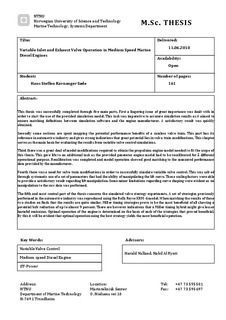| dc.contributor.author | Sæle, Hans Steffen Ravnanger | nb_NO |
| dc.date.accessioned | 2014-12-19T12:06:10Z | |
| dc.date.available | 2014-12-19T12:06:10Z | |
| dc.date.created | 2010-12-08 | nb_NO |
| dc.date.issued | 2010 | nb_NO |
| dc.identifier | 375519 | nb_NO |
| dc.identifier.uri | http://hdl.handle.net/11250/237831 | |
| dc.description.abstract | This thesis was successfully completed through five main parts. First a lingering issue of great importance was dealt with in order to start the use of the provided simulation model. This task was imperative to accurate simulation results as it aimed to ensure matching definitions between simulation software and the engine manufacturer. A satisfactory result was quickly obtained.
Secondly some sections are spent mapping the potential performance benefits of a camless valve train. This part has its reference in automotive industry and gives strong indications that great potential lies in valve train modifications. This chapter serves as the main basis for evaluating the results from variable valve control simulations.
Third there was a great deal of model modifications required to obtain the propulsion engine model needed to fit the scope of this thesis. This gave life to an additional task as the provided generator engine model had to be recalibrated for å different operational purpose. Recalibration was completed and model operation showed good matching to the measured performance data provided by the manufacturer.
Fourth there was a need for valve train modifications in order to successfully simulate variable valve control. This was solved through systematic use of a set of parameters that had the ability of manipulating the lift curve. These scaling factors were able to provide a satisfactory result regarding lift manipulation. Some minor limitations regarding curve shaping were evident as no manipulation to the raw data was performed.
The fifth and most central part of the thesis concerns the simulated valve strategy experiments. A set of strategies previously performed in the automotive industry was reproduced using the Rolls Royce KRM-6 model. When matching the results of these two studies on finds that the results are quite similar. Miller timing strategies prove to be the most beneficial of all showing a potential bsfc reduction of up to almost 9 percent. There are however indications that a Miller timing hybrid might give lesser harmful emissions. Optimal operation of the engine is determined on the basis of each of the strategies that proved beneficial. By this it will be evident that optimal operation using the best strategy yields the most beneficial operation. | nb_NO |
| dc.language | eng | nb_NO |
| dc.publisher | Norges teknisk-naturvitenskapelige universitet, Fakultet for ingeniørvitenskap og teknologi, Institutt for marin teknikk | nb_NO |
| dc.title | Variable Inlet and Exhaust Valve Operation in Medium Speed Marine Diesel Engines | nb_NO |
| dc.type | Master thesis | nb_NO |
| dc.contributor.department | Norges teknisk-naturvitenskapelige universitet, Fakultet for ingeniørvitenskap og teknologi, Institutt for marin teknikk | nb_NO |
